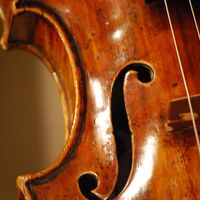By Andy Fein, Violin Maker and Owner, Fein Violins, Ltd.
Take a sidelong look at your violin, viola or cello. You'll notice that the top and the back are not flat. In fact, they have pretty complicated curves rounding up side to side and from the neck to under the tailpiece. Those curves are called the arching of your instrument.
The arching is pretty important! In a large generality, the arching is what makes your stringed instrument sound and function the way that it does. Without those curves (that is, with a flat top and back) your instrument wouldn't be able to stand up to the pressure of the strings and it wouldn't have the immense acoustic power to fill a concert hall.
Need a real world example? A classical guitar has a flat back and top. A guitar soloist with an orchestra (such as playing the 'Aranjuez') is almost always amplified via a microphone. Not so with a violin family instrument. The acoustic power that is derived from the arching is one of the reasons you can hear a violin soloist at the back of a large hall.
How is the arching achieved? The top and back are carved to that shape. Spruce for the top, Maple for the back. Starting with solid pieces, the top and back are worked to their final shape with gouges, finger planes, and scrapers. Most modern makers follow a few variations on models of Stradivarius or Guarnerius. That was not the case throughout history and there has been a lot of experimentation.
Take a sidelong view of several instruments. You'll see that the shape and height of the arching can vary quite a bit. Some instruments have high arching, some quite flat, and most are somewhere in between.
Many older instruments have very high arching. Look at them from the side and they look like a football. In the early centuries of violin making and playing, highly arched instruments were more sought after than flatter instruments. The higher arching gives a sweeter sound but isn't very loud and doesn't carry very far. Not carrying far and not being very loud were not a problem when the concert halls were small and the player did not have to contend with the background noise of cars, trains, planes, sirens, ventilation systems and other machinery. The higher arched instruments of Jacobus Stainer and the Amatis were more highly valued than the flatter instruments of Stradivarius and Guarnerius.
As our world became louder and as concert halls became larger, the highly arched instruments lost favor to the flatter arched instruments. Who cares if your violin has a really sweet sound when you can't hear it past the middle of the hall? At the same time, the note A was rising (A 440, Not So Standard). Higher arched instruments had a harder time responding to the advances in playing and pitch.
The structure of the arching is also the reason we have three and four hundred year old instruments that are still playable. Ever hear of the The Roman Arch? The Roman Arch is one of the strongest structures humans have ever invented. The top and back of your instrument are an elaboration of the Roman Arch - strong, able to resist a tremendous amount of pressure (most of the time!) and very stable. Most flat stringed instruments (like guitars) do not last nearly as long.
Eventually, even the strongest arch starts to give out. Many instruments eventually sink. If you look at the arch directly under the strings, the highest point should be under the bridge or close to the bridge. Interestingly, if the instrument stays glued up, it remains a closed system. The string pressure will start to push the arch down at the bridge, but it will have to go up somewhere else. The arch will rise under the fingerboard and under the tailpiece. To the casual observer, it will look like the neck and fingerboard have bent forward, sometimes with the fingerboard touching the top. Unfortunately, with the arch sinking, the situation is far more complicated.
A sunken arch can be repaired and restored, but it is a complicated (and expensive!) process involving removing the top, carefully pressing the arch back into shape, patching, replacing the bass bar, and putting the instrument back together.
Take a look at your instrument with a new appreciation. Yes, your instrument has some great curves. Those curves serve your musicianship every day, tasking the pressure of the strings, vibrating in unique patterns, and pushing those vibrations into the air around you. That vibrating air becomes the sound that you and your audience hear. So, thank those pieces of wood that been shaped for you and thank the centuries of luthiers that have experimented with styles of arching to bring you the best sounding instruments.
Take a sidelong look at your violin, viola or cello. You'll notice that the top and the back are not flat. In fact, they have pretty complicated curves rounding up side to side and from the neck to under the tailpiece. Those curves are called the arching of your instrument.
 |
| A view of the arching of an Andreas Guarnerius viola |
The arching is pretty important! In a large generality, the arching is what makes your stringed instrument sound and function the way that it does. Without those curves (that is, with a flat top and back) your instrument wouldn't be able to stand up to the pressure of the strings and it wouldn't have the immense acoustic power to fill a concert hall.
 |
| A view of the arching of an Amati cello |
Need a real world example? A classical guitar has a flat back and top. A guitar soloist with an orchestra (such as playing the 'Aranjuez') is almost always amplified via a microphone. Not so with a violin family instrument. The acoustic power that is derived from the arching is one of the reasons you can hear a violin soloist at the back of a large hall.
 |
| The arching of a Nicolas Amati violin |
How is the arching achieved? The top and back are carved to that shape. Spruce for the top, Maple for the back. Starting with solid pieces, the top and back are worked to their final shape with gouges, finger planes, and scrapers. Most modern makers follow a few variations on models of Stradivarius or Guarnerius. That was not the case throughout history and there has been a lot of experimentation.
 |
| A violin top being carved to shape |
Take a sidelong view of several instruments. You'll see that the shape and height of the arching can vary quite a bit. Some instruments have high arching, some quite flat, and most are somewhere in between.
 |
| A view of the top and back arching of a Bergonzi viola |
Many older instruments have very high arching. Look at them from the side and they look like a football. In the early centuries of violin making and playing, highly arched instruments were more sought after than flatter instruments. The higher arching gives a sweeter sound but isn't very loud and doesn't carry very far. Not carrying far and not being very loud were not a problem when the concert halls were small and the player did not have to contend with the background noise of cars, trains, planes, sirens, ventilation systems and other machinery. The higher arched instruments of Jacobus Stainer and the Amatis were more highly valued than the flatter instruments of Stradivarius and Guarnerius.
 |
| Arching in the bridge area of a Guarnerius del Gesu violin |
 |
| The arching on a Stainer cello |
As our world became louder and as concert halls became larger, the highly arched instruments lost favor to the flatter arched instruments. Who cares if your violin has a really sweet sound when you can't hear it past the middle of the hall? At the same time, the note A was rising (A 440, Not So Standard). Higher arched instruments had a harder time responding to the advances in playing and pitch.
The structure of the arching is also the reason we have three and four hundred year old instruments that are still playable. Ever hear of the The Roman Arch? The Roman Arch is one of the strongest structures humans have ever invented. The top and back of your instrument are an elaboration of the Roman Arch - strong, able to resist a tremendous amount of pressure (most of the time!) and very stable. Most flat stringed instruments (like guitars) do not last nearly as long.
 |
| The Stone Arch Bridge, Minneapolis |
 |
| The arching of the Messiah Stradivarius violin |
Eventually, even the strongest arch starts to give out. Many instruments eventually sink. If you look at the arch directly under the strings, the highest point should be under the bridge or close to the bridge. Interestingly, if the instrument stays glued up, it remains a closed system. The string pressure will start to push the arch down at the bridge, but it will have to go up somewhere else. The arch will rise under the fingerboard and under the tailpiece. To the casual observer, it will look like the neck and fingerboard have bent forward, sometimes with the fingerboard touching the top. Unfortunately, with the arch sinking, the situation is far more complicated.
A sunken arch can be repaired and restored, but it is a complicated (and expensive!) process involving removing the top, carefully pressing the arch back into shape, patching, replacing the bass bar, and putting the instrument back together.
Take a look at your instrument with a new appreciation. Yes, your instrument has some great curves. Those curves serve your musicianship every day, tasking the pressure of the strings, vibrating in unique patterns, and pushing those vibrations into the air around you. That vibrating air becomes the sound that you and your audience hear. So, thank those pieces of wood that been shaped for you and thank the centuries of luthiers that have experimented with styles of arching to bring you the best sounding instruments.
 |
| Sidelong view showing the arching on a 1500s Andrea Amati violin |
the concept of high arching being not loud is controversial... i am making violins with high arcs but sound is still loud and carries far away... all depends where you put the highest point of the arc in relation to bridge and sound post... this is my humble experience. robert kfouri, violin maker.
ReplyDeleteThanks for the interesting articles. I was curious to check if there was any sinking on my 242-year-old Robert Thompson cello. If so, it's very slight. It's not the loudest cello but it has such a beautiful sound. Anybody know who Thompson patterned his cellos after?
ReplyDeleteIs the arch of a stringed instrument carved or bent?
ReplyDelete